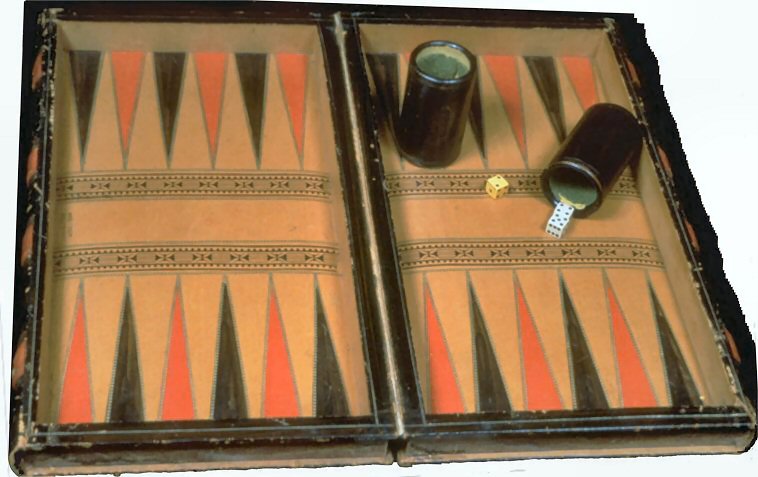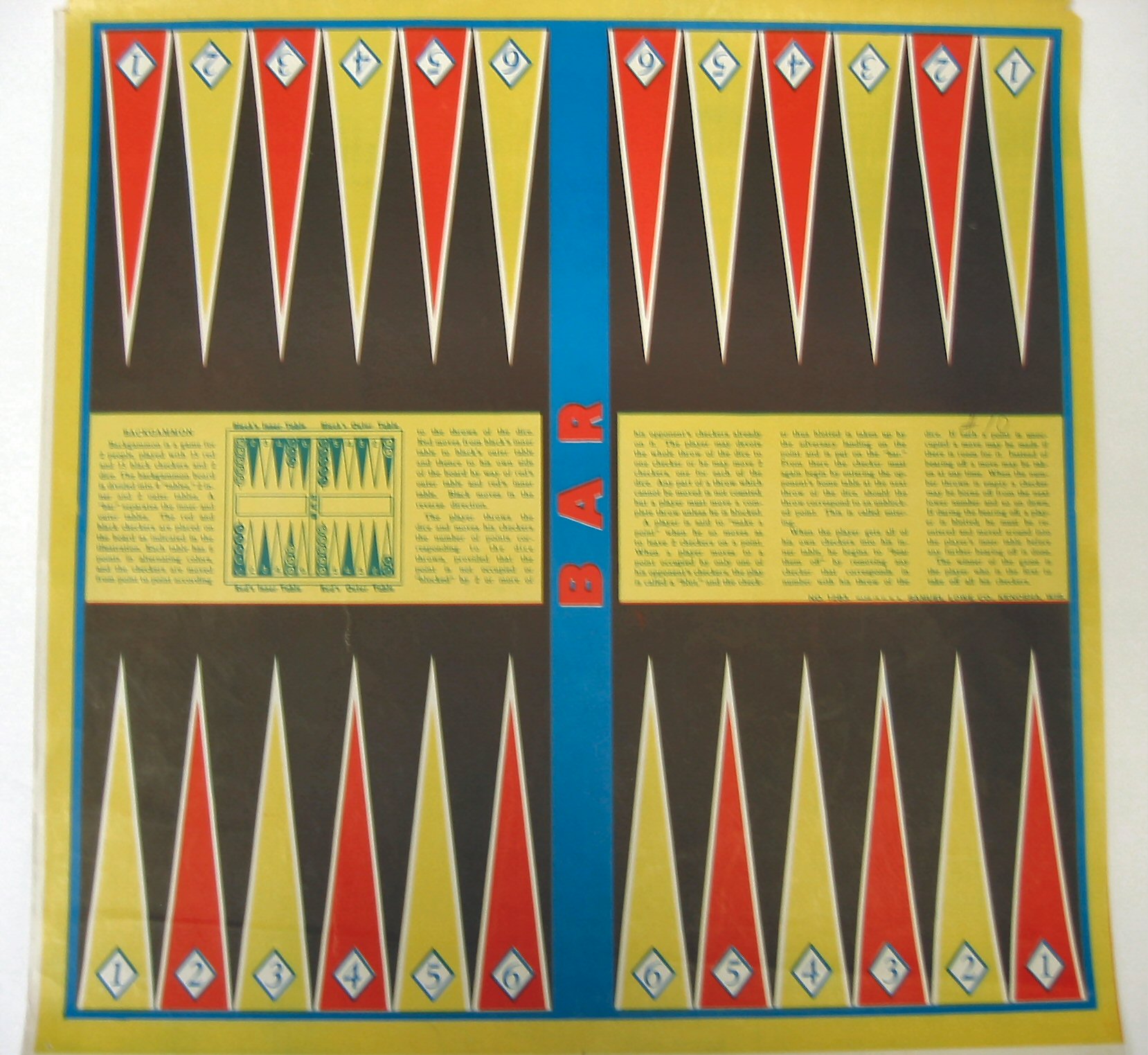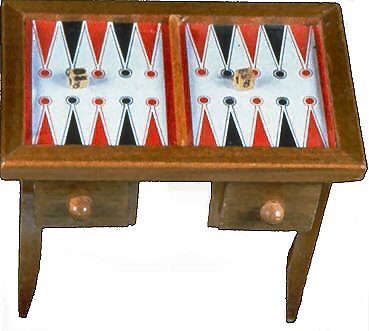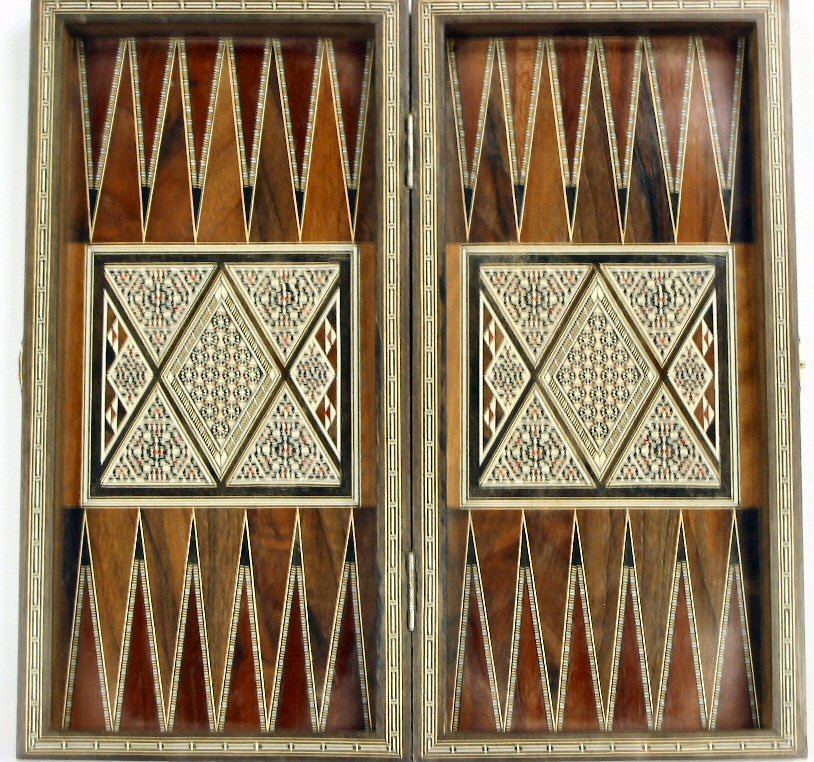Today around the world, the standard backgammon game is for two players. The Museum has a number of backgammon sets in the collection. Here are some examples from the collection:

In the 19th century either storage of games was an issue, or the owner of these backgammon sets didn't want others to know that they had such a set!
When the board on the left is closed it appears to be a set of two large books that could be placed on a typical bookshelf. On the spine of the first "book" an imprint in gold letters is Evenings At Home Vol. 1. The second spine had almost the same imprint - Evenings At Home Vol. 2. Along with the imprint are floral designs on a brown band alternating with geometric designs on a red band. The two "volumes" are 42.7cm long x 24cm wide x 7cm thick. The Museum purchased this set from an antique shop in Vermont (US) in 1981. The set was produced in 1884. The set on the right is somewhat smaller, but similar.

When the "books" are open they reveal a standard backgammon board of 42.7cm long x 48cm wide x 3.5cm thick(photograph on the right). The set includes two dice boxes with green felt interiors 4.9cm diameter x 8.9cm high, and a 1.2cm cubed bone dice. A pair of white contemporary dice have been added to the photograph for comparison purposes.

An even more interesting comparison is the contemporary travel backgammon set pictured on the left. This set was donated to the Museum in 1972. When the case is closed it is 52.3cm long x 34.9cm wide x 5.5cm thick. When open it is 69.7cm wide x 2.7cm thick. The outside of the case is covered with a leather-like plastic coating. The hinges and locks (with a key) are brass. There are two brass fittings to which a leather handle was originally attached. The playing surface of the board is a cork-like substance. The dice cups are made of leather, and snap together, and can be opened to lay flat when the board is closed for traveling or storage.
The set includes 30 3.7cm diameter x 1.2cm thick plastic playing pieces which are stored in compartments on the right side of the case, allowing the case to close. The set includes a 2.4cm betting cube with the Arabic numbers 2, 4, 8, 26, 32, 64. There are two sets of standard plastic dice 1.6cm cubes - one set is yellow with brown dots, and the other set is brown with yellow dots.

Donated to the Museum in 1983, this combination travel backgammon and chess set was manufactured by the "Pacific Western" company whose name can be seen in the center of both sides of the board in the photograph on the left. The board is a single piece of stryofoam (25.7cm long x 19.3cm wide) with painted markings. The side showing has the backgammon design, the reverse side is an 8x8 checkered matrix used for chess and checkers. There are 16 pink styrofoam discs and 16 turquoise stryofoam discs (1.5cm diameter x .2cm thick) imprinted with silhouettes of standard chess symbols that can be used for all three games. All reverse sides are blank. Two plastic standard white dice with black pips are included.
As a travel version, the discs and the dice are placed on the board, and since it is stryofoam, the board is rolled up and ready to take up little space in one's luggage.

Manufactured by the Samuel Lowe Company of Kenosha Wisconsin, US, in the 1940s, this set was donated to the Museum in 1983. It is of interest because it has the instructions for the game of backgammon imprinted on the board. However, these are not just instructions, these are intended to "teach" a new player how to play the game of backgammon. The board is printed paper glued to a cardboard backing. It is 39.5cm long x 38.5 cms wide. The illustration explains the initial set-up of the game, and then specifiy the various movement of the pieces during play. The "points" are numbered in the illustration only. The instructions indicate that players can use a standard set of "checkers" as playing pieces, and a standard pair of dice. Below are these instructions.
 |
 |
 |
 |
 |
 |

For many years, special furniture tables with inlaid backgammon boards have been available in a number of countries of the world. To illustrate this aspect of the game, the Museum collection includes a miniature backgammon table that is complete with removable drawers. This "dollhouse" backgammon set was purchased in 1979. It was manufactured by Shackman, Inc., New York City, Serial-Number 7438. The table is 5.6cm long x 8.8cm wide x 6.8cm high. It is made of wood and paper. The two wooden .4cm "dice" are glued to the board. The colors of the game board (red and black) are typical of many standard cardboard backgammon sets on the market today.
Among the many different types of backgammon sets in the Museum collection is a special set produced by the Selchow & Righter Co. in 1977. This set is Backgammon For Juniors. The set includes a playing surface with pockets in the middle of the board that hold "programmed instruction" cards intended to teach and explain each move. The reverse of this board is a standard backgammon board.

One "real" museum item in the collection is a "floppy disc" produced by the Compucolor Computer Corporation in 1979. This is the era before the well known desktop computer came on the scene. This "floppy" version of backgammon was coded in Compucolor's form of the Basic language, and made special graphic "calls" that could only be understood by the Compucolor Computer. Today there are a number of computerized backgammon games that are available on CDROM and can be played on any number of desktop computers.
Perhaps one of the most beautiful boards in the Museum collection is the handmade board pictured on the left. This board was made in Baghdad, Iraq in the "Jewish Quater". The board is typical of the type of work permitted in this quarter over the centuries. The board was an import, and was purchased in Budapest, Hurgary in the 1960s, and donated to the Museum in 1971.
The board is a folding board with a chess matrix on the outside, and a backgammon board on the inside. When open to the backgammon side, the board is 39.8cm x 39.5cm x 3.8cm. It is made of several types of wood with inlaid ivory, shell, and metal wire. There are brass clasps and hinges for closing the board.
Last update February 4, 2010